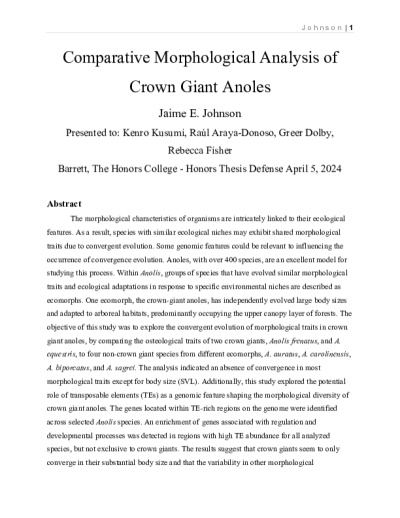Filtering by
- All Subjects: Evolution
- Creators: School of Life Sciences
A mutation rate refers to the frequency at which DNA mutations occur in an organism over time. In organisms, mutations are the ultimate source of genetic variation on which selection may act. However, a large number of mutations over time can be detrimental to the cell. Mutation rates are the frequency at which these new mutations arise over time. This can give great insight into DNA repair mechanisms abilities as well as the mutagenic abilities of selected factors. CRISPR-Cas9 is a powerful tool for genome editing, but its off-target effects are not yet fully understood and studied. With its increasing implementation in science and medicine, it is crucial to understand the mutagenic potential of the tool. S. cerevisiae is a model organism for studying genetics due to its fast growth rate and eukaryotic nature. By integrating CRISPR-Cas9 systems into S. cerevisiae, the mutational burden of the technology can be measured and quantified using fluctuation assays. In this experiment, a fluctuation assay using canavanine selective plates was conducted to determine the mutational burden of CRISPR-Cas9 in S. cerevisiae. Multiple trials revealed that various strains of CRISPR-Cas9 had a mutation rate up to 3-fold higher than that of wild-type S. cerevisiae. This information is essential in improving the precision and safety of CRISPR-Cas9 editing in various applications, including gene therapy and biotechnology.
Our cells need constant fuel and oxygen for the body to work properly and maintain cellular function. In high altitudes tissue oxygen levels fall and the body must work against this hypoxic challenge to maintain energetics and limit oxidative stress. Mammals living at high altitudes are challenged to sustain thermogenesis and aerobic exercise despite reduced amounts of available oxygen. Enhancements in oxidative capacity and oxygen diffusion capacity of skeletal muscle may be necessary to compensate for insufficient oxygen supply in tissues. Hypoxic conditions can cause a switch from aerobic metabolism to anaerobic metabolism. Due to previous research of Graham Scott and colleagues on “Adaptive Modifications of Muscle Phenotype in High-Altitude Deer Mice” and the SMack Lab at Arizona State University, the question of how low atmospheric oxygen levels affects the enzymatic activity in the gastrocnemius muscle of Gelada Monkeys compared to Rhesus Macaque Monkeys was researched. Lactate Dehydrogenase (LDH) activity was measured in the gastrocnemius tissue of 6 Gelada Monkeys (highland) and 6 Rhesus Macaque monkeys (lowland). LDH was expected to be greater in Gelada tissue samples due to heightened anaerobic metabolism in the presence of limited available oxygen in high altitude environments. Results showed higher LDH in Rhesus Macaque samples compared to Gelada samples, but this difference was not statistically significant. Despite nonsignificant data, this experiment is insightful into the effects of Hypoxic adaptation in skeletal muscle enzymatic activity in primates.

The relationship between science and religion in the modern day is complex to the point that the lines between them are often blurred. We have a need to distinguish the two from each-other for a variety of practical reasons. Various philosophies, theories, and tests have been suggested on the interaction between the two and how they are subdivided. One of the sets of criteria which has been shown to work was originally introduced in the opinion of Judge Overton in the case of McLean v Arkansas. McLean v Arkansas is a pivotal case in that it gave us a useful definition of what science is and isn’t in the context of the law. It used the already established Lemon test to show what counts as the establishment of religion. Given the distinction by Judge Overton, there are questions as to whether or not there is even overlap or tension between science and religion, such as in the theory of Stephen Jay Gould’s Nonoverlapping Magisteria (NOMA). What we find in this thesis is that the NOMA principle is doubtful at best. Through the discussion of McLean v. Arkansas, NOMA, and the commentaries of Professors Larry Laudan and Michael Ruse, this thesis develops a contextualization principle that can be used as a guide to develop further theories, particularly regarding the divisions between science and religion.


Cooperative cellular phenotypes are universal across multicellular life. Division of labor, regulated proliferation, and controlled cell death are essential in the maintenance of a multicellular body. Breakdowns in these cooperative phenotypes are foundational in understanding the initiation and progression of neoplastic diseases, such as cancer. Cooperative cellular phenotypes are straightforward to characterize in extant species but the selective pressures that drove their emergence at the transition(s) to multicellularity have yet to be fully characterized. Here we seek to understand how a dynamic environment shaped the emergence of two mechanisms of regulated cell survival: apoptosis and senescence. We developed an agent-based model to test the time to extinction or stability in each of these phenotypes across three levels of stochastic environments.


Through man-made structures, human interference, artificial lights at night, and electromagnetic fields we have caused animals and insects to evolve and fit these new environments. While we tail the world around us to convince ourselves, the animals also living in these environments need to adapt to survive. In this essay, I will discuss how the affects mentioned above have cause crows, moths, snails, bobcats, blackbirds, mosquitoes, elephants, diurnal animals, fireflies, dung beetles, birds and bats to evolve. The adaptations these organisms made were caused by the subtle ways in which we have impact the landscapes around us.
